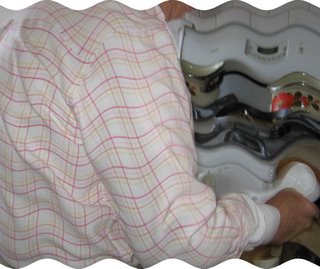
Several weeks ago on a beautiful winter day, I stopped to take photos of the LaCygne fossil fuel power plant located about 50 miles south of Kansas City. You can't see it in this photo which shows mostly steam, but the two stacks visibly release a continuous stream of hazardous particles that spread out downwind in long clouds that sometimes stretch to the horizon.
Interestingly, the
Wolf Creek nuclear power plant about 90 miles southwest of Kansas City and the
Callaway nuclear plant 100 miles west of St. Louis are much cleaner facilities. They don't burn coal or oil to release either hazardous particles or dangerous gases. Moreover, both plants use U.S.-produced uranium that costs less than 1/4 that of fossil fuels.
I have supported nuclear power for over 40 years--ever since hearing Dr. Petr Beckmann, professor emeritus at Colorado University, speak of the many advantages of clean nuclear power. Beckmann was a well-known engineer/mathematician who wrote
several good books, including "A History of Pi" (still being published long after his death), and "Health Hazards of Not Going Nuclear."
Dr. Beckmann told the story of how a god appeared in Washington, D.C. in the late 19th century asking our country to make a deal in exchange for sacrificial bodies of humans. The god promised to give the U.S. a great gift if it would give 40,000 human lives to him each year. The spectacular and miraculous gift would help people live better lives, move about much more freely, bring distant families closer together, enlarge the number of jobs, build up the nation, etc.--a wealth of benefits. Most certainly if the nation had been permitted to vote, the god's proposal would clearly have been rejected.
Beckman pointed out the gift was the automobile, and the sacrificial gift is the over 40,000 lives lost each year due to auto accidents in the U.S. [According to the World Health Organization about
3,000 people die in crashes each day worldwide.] We know that automobiles cause many accidents but we choose to drive anyway--KNOWING AND ACCEPTING the comparative risks and rewards.
It's much the same with risks of nuclear power as compared to fossil fuel power. We choose to continue to live with fossil-fueled generating stations that cause almost 1,000 premature deaths a year in the U.S. due to people inhaling hazardous emissions. Most people seem not to acknowledge this fact and that coal ash is more radioactive than nuclear waste.
Huh! Did I just say coal ash is more radioactive than nuclear waste? How so? Take at look at this recent
Scientific American article to understand why fly ash—a by-product from burning coal for power—contains up to 100 times more radiation than nuclear waste.
BTW, what happens to radioactive fly ash after it is removed? Construction and non-construction industries both use fly ash (e.g., concrete), but most fly ash from coal fired power stations is disposed of as a dilute or dense slurry in evaporative ponds, to be later buried with soil. Here's one typical illustration of
current disposal of radioactive and hazardous fly ash.Currently, there are 103 operating commercial nuclear reactors producing electricity in the United States located at 64 sites in 31 states. Unfortunately, no new nuclear reactor in the U.S. has been ordered since 1978, even though no direct deaths are attributable to accidents releasing radioactivity at nuclear power plants in the U.S. during the past 40 years.
In comparison, many other countries in the world have built and continue to construct many new nuclear plants, including Japan. What? Japan should hate nuclear power because they were the only nation that has been nuclear bombed. But here are
descriptions of Japan's 53 operating nuclear power plants, including the new nuclear facilities now being constructed.
The Three Mile Island and Chernobyl nuclear accidents were caused by faulty designs, operation, and maintenance. Did you know that Chernobyl Unit IV, during its short life of 27 months, saved more lives from coal pollution than it took by radiation (or will take in the future, for coal has delayed deaths, too). See
here.
New nuclear power plants (if we would be smart enough to build them) are designed to prevent the possibility of any meltdown. A PBS documentary of about 7-10 years ago showed congressmen and other visitors becoming agitated as a demo plant funded by government research began to reach meltdown and all the warning sirens activated. But the fission process automatically stopped and nothing happened--because the new nuclear plant design is inherently safe.
Even former "super-environmentalists" such as Stewart Brand (creator of the
Whole Earth Catalogue), Patrick Moore (former Greenpeace activist), Christine Todd Whitman (former EPA chief), and Governor Arnold Schwarzenegger now support the building of new nuclear plants because they recognize the futility of obtaining sufficient amounts of power from solar, wind, thermal, and other sources of energy. Only nuclear energy can meet the federal Energy Information Administration estimate of U.S. power requirements that are expected to climb 40 percent by 2030. Many environmentalists also are beginning to recognize that solar cell manufacturing releases really hazardous materials, wind turbines kill eagles and cause noise pollution, and other sources of 'natural' energy cause grave environmental problems exceeding that of nuclear energy.
Possible terrorism at nuclear power plants? Oh, yes, let's answer that one too. Take a look at an example of
what Wolf Creek Nuclear Power Plant is doing to prevent such an occurrence. Kansas legislators must believe more nuclear power is necessary because they have enacted
a 10-year tax break for any developer willing to invest in a new unit at Wolf Creek.
It's too bad that politicians listened to super-environmentalists rather than scientists and engineers for the past 30 years. Our country should have built at least three times as many nuclear plants as we now have. Compare our current 103 nuclear plants to the Atomic Energy Commission's prediction in 1959 of more than 1,000 U.S. nuclear plants by the turn of the century. If we had done what we should have done, we now would have no good reason to be in Iraq trying to insure a reliable supply of oil.









